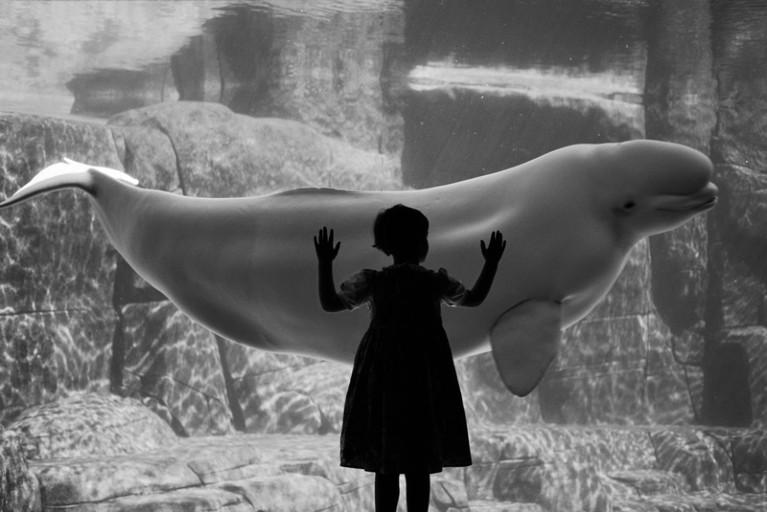
Science-fiction stories can explore the future of the world’s fisheries.Credit: Grant Faint/Getty
Among the many things that SpaceX likes to do differently is name its hardware. Last month, chief executive Elon Musk announced that the company’s latest droneship (the floating ocean platforms designed to receive reusable rocket launch boosters) will be known as A Shortfall of Gravitas. It will join existing barges Just Read the Instructions and Of Course I Still Love You.
The names will be familiar to readers of the Scottish author Iain M. Banks (who died in 2013) as based on spacecraft from his Culture series of science-fiction novels. And Banks is about to get an even wider audience: tech entrepreneur Jeff Bezos is also a fan, and his firm Amazon has announced plans to film the first of the Culture books.
The path from science fiction to science fact has been well explored, especially in areas such as space and technology, with inventions from satellites to iPads first imagined in stories. But can the influence go further? What if it is not the concepts described by science fiction that could have the most impact, but the act of storytelling — the creation of scientific narratives — itself?
That’s the goal of something called science-fiction prototyping. Developed by Brian David Johnson at computer company Intel a decade or so ago to help the firm’s engineers anticipate future demand, the approach takes scientific facts and spins them into the future to explore the societal scenarios that could emerge. Advocates say an emphasis on exploring how humans might react to technological change creates a “focused, tailored and creative way to think about possible futures around a particular issue” (A. Merrie et al. Futures 95, 22–32; 2018). It differs from other forms of scenario planning, they argue, because the emphasis is placed as much on the narrative used to explore the results as on the results themselves, and because the goal is not to reach a predetermined outcome. The method has been used by researchers at the University of Essex, UK, and King Abdulaziz University in Jeddah, Saudi Arabia, to create and test a virtual-reality-based distance-learning tool originally imagined for the year 2048 that they call the BReal Lab (go.nature.com/2fhz9za).
Sustainability scientist Andrew Merrie at Stockholm University and his colleagues have taken this principle and applied it to a topical environmental concern: the fate of the world’s oceans. The project paints four scenarios for 2050–70, each of which builds on current trends in oceans governance and the fishing industry, as well as ongoing development of marine science and technology. More-uncertain outcomes — the possible collapse of ice sheets and the formation of deep-sea dead zones as a result of onshore pollution — play out differently for better and worse.
One scenario, called Oceans Back from the Brink, describes a public talk given in 2070 about how an artificial-intelligence system released all forms of confidential data, which prompted the collapse of existing corporate structures and renewed conservation efforts. Another, Rime of the Last Fisherman — Dispatches from a Dying Ocean, imagines a less-than happy ending, with decaying oceans, a geoengineering experiment gone badly wrong and onshore disaster.
The paper in Futures is accompanied by striking illustrations on the project’s website.
Narrative has an important role in the communication of science, but can it also help in the pursuit of research? Purists may baulk, but stories already feature heavily, from the promised potential of work pitched in grant applications to the case studies of impact that funders increasingly ask for when projects finish. Climate-change science has long relied on emissions scenarios that diverge according to how future societies might behave. These rely not on extrapolation of current trends, but on imagined differences in, for example, whether nations come to cooperate or opt to pursue their own agendas. And climate-change policies are being planned on the basis of stories of future technology — carbon capture and negative-emissions equipment included — that many argue are pure fiction and will never materialize.
Some of the scenarios painted — in both the fictional tales of the future ocean and the high-emissions scenarios of climate modellers — are something that society, scientists included, should be desperate to avoid. To do so, data and evidence remain the priority. But in a world where both are so easily trumped by a seductive (and false) counter-narrative, perhaps more researchers should also learn to tell tales as they look ahead.

 Where Bladerunner began: 50 years of Do Androids Dream of Electric Sheep?
Where Bladerunner began: 50 years of Do Androids Dream of Electric Sheep?
 How to write for Nature Futures
How to write for Nature Futures
 Science fiction: Boldly going for 50 years
Science fiction: Boldly going for 50 years
 Science fiction when the future is now
Science fiction when the future is now
 Q&A: The sci-fi optimist
Q&A: The sci-fi optimist





